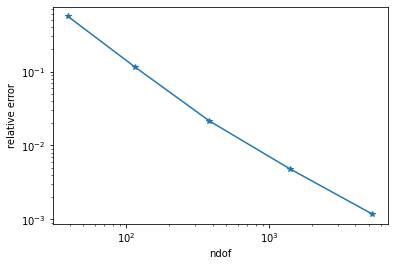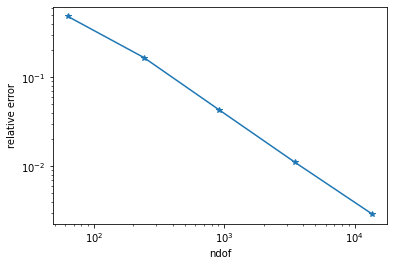This page was generated from unit-6.1.3-rmplate/Reissner_Mindlin_plate.ipynb.
6.1.3 Reissner-Mindlin plate¶
To avoid shear locking when the thickness \(t\) becomes small several methods and elements have been proposed. We discuss two approaches:
1: Mixed Interpolation of Tensorial Components (MITC)
2: Rotations in Nèdèlec space using the Tangential-Displacement Normal-Normal-Stress method (TDNNS)
Mixed Interpolation of Tensorial Components (MITC)¶
[1]:
from ngsolve import *
from netgen.geom2d import SplineGeometry
from ngsolve.webgui import Draw
Set up benchmark example with exact solution. Young modulus \(E\), Poisson ratio \(\nu\), shear correction factor \(\kappa\) and corresponding Lamè parameters \(\mu\) and \(\lambda\). Geometry parameters are given by thickness \(t\) and radius \(R\).
[2]:
E, nu, k = 10.92, 0.3, 5/6
mu = E/(2*(1+nu))
lam = E*nu/(1-nu**2)
#shearing modulus
G = E/(2*(1+nu))
#thickness, shear locking with t=0.1
t = 0.1
R = 5
#force
fz = 1
order = 1
Due to symmetry we only need to mesh one quarter of the circle.
[3]:
sg = SplineGeometry()
pnts = [ (0,0), (R,0), (R,R), (0,R) ]
pind = [ sg.AppendPoint(*pnt) for pnt in pnts ]
sg.Append(['line',pind[0],pind[1]], leftdomain=1, rightdomain=0, bc="bottom")
sg.Append(['spline3',pind[1],pind[2],pind[3]], leftdomain=1, rightdomain=0, bc="circ")
sg.Append(['line',pind[3],pind[0]], leftdomain=1, rightdomain=0, bc="left")
mesh = Mesh(sg.GenerateMesh(maxh=R/3))
mesh.Curve(order)
Draw(mesh)
Generate Mesh from spline geometry
Boundary mesh done, np = 11
CalcLocalH: 11 Points 0 Elements 0 Surface Elements
Meshing domain 1 / 1
load internal triangle rules
Surface meshing done
Edgeswapping, topological
Smoothing
Split improve
Combine improve
Smoothing
Edgeswapping, metric
Smoothing
Split improve
Combine improve
Smoothing
Edgeswapping, metric
Smoothing
Split improve
Combine improve
Smoothing
Update mesh topology
Update clusters
Curve elements, order = 1
Update clusters
[3]:
BaseWebGuiScene
Depending on the boundary conditions (simply supported or clamped) we have different exact solutions for the vertical displacement.
[4]:
r = sqrt(x**2+y**2)
xi = r/R
Db = E*t**3/(12*(1-nu**2))
clamped = True
#exact solution for simply supported bc
w_s_ex = -fz*R**4/(64*Db)*(1-xi**2)*( (6+2*nu)/(1+nu) - (1+xi**2) + 8*(t/R)**2/(3*k*(1-nu)))
#Draw(w_s_ex, mesh, "w_s_ex")
#exact solution for clamped bc
w_c_ex = -fz*R**4/(64*Db)*(1-xi**2)*( (1-xi**2) + 8*(t/R)**2/(3*k*(1-nu)))
Draw(w_c_ex, mesh, "w_c_ex")
[4]:
BaseWebGuiScene
Use (lowest order) Lagrangian finite elements for rotations and the vertical deflection together with additional internal bubbles for order >1.
[5]:
if clamped:
fesB = VectorH1(mesh, order=order, orderinner=order+1, dirichletx="circ|left", dirichlety="circ|bottom", autoupdate=True)
else:
fesB = VectorH1(mesh, order=order, orderinner=order+1, dirichletx="left", dirichlety="bottom", autoupdate=True)
fesW = H1(mesh, order=order, orderinner=order+1, dirichlet="circ", autoupdate=True)
fes = FESpace( [fesB, fesW], autoupdate=True )
(beta,u), (dbeta,du) = fes.TnT()
WARNING: kwarg 'orderinner' is an undocumented flags option for class <class 'ngsolve.comp.VectorH1'>, maybe there is a typo?
WARNING: kwarg 'orderinner' is an undocumented flags option for class <class 'ngsolve.comp.H1'>, maybe there is a typo?
WARNING: kwarg 'autoupdate' is an undocumented flags option for class <class 'ngsolve.comp.FESpace'>, maybe there is a typo?
Direct approach where shear locking may occur
Adding interpolation (reduction) operator \(\boldsymbol{R}:[H^1_0(\Omega)]^2\to H(\text{curl})\). Spaces are chosen according to [Brezzi, Fortin and Stenberg. Error analysis of mixed-interpolated elements for Reissner-Mindlin plates. Mathematical Models and Methods in Applied Sciences 1, 2 (1991), 125-151.]
[6]:
Gamma = HCurl(mesh,order=order,orderedge=order-1, autoupdate=True)
a = BilinearForm(fes)
a += t**3/12*(2*mu*InnerProduct(Sym(grad(beta)),Sym(grad(dbeta))) + lam*div(beta)*div(dbeta))*dx
#a += t*k*G*InnerProduct( grad(u)-beta, grad(du)-dbeta )*dx
a += t*k*G*InnerProduct(Interpolate(grad(u)-beta,Gamma), Interpolate(grad(du)-dbeta,Gamma))*dx
f = LinearForm(fes)
f += -fz*du*dx
gfsol = GridFunction(fes, autoupdate=True)
gfbeta, gfu = gfsol.components
WARNING: kwarg 'orderedge' is an undocumented flags option for class <class 'ngsolve.comp.HCurl'>, maybe there is a typo?
Define function for solving the problem.
[7]:
def SolveBVP():
fes.Update()
gfsol.Update()
with TaskManager():
a.Assemble()
f.Assemble()
inv = a.mat.Inverse(fes.FreeDofs(), inverse="sparsecholesky")
gfsol.vec.data = inv * f.vec
Solve, compute error, refine, …
[8]:
l = []
for i in range(5):
print("i = ", i)
SolveBVP()
if clamped:
norm_w = sqrt(Integrate(w_c_ex*w_c_ex, mesh))
err = sqrt(Integrate((gfu-w_c_ex)*(gfu-w_c_ex), mesh))/norm_w
else:
norm_w = sqrt(Integrate(w_s_ex*w_s_ex, mesh))
err = sqrt(Integrate((gfu-w_s_ex)*(gfu-w_s_ex), mesh))/norm_w
print("err = ", err)
l.append ( (fes.ndof, err ))
mesh.Refine()
i = 0
assemble VOL element 13/13
assemble VOL element 13/13
err = 0.5595598334579744
Mesh bisection
resetting marked-element information
Update mesh topology
Update clusters
Bisection done
Update clusters
i = 1
assemble VOL element 52/52
assemble VOL element 52/52
err = 0.11654484017074333
Mesh bisection
Update mesh topology
Update clusters
Bisection done
Update clusters
i = 2
assemble VOL element 208/208
assemble VOL element 208/208
err = 0.021448789398276467
Mesh bisection
Update mesh topology
Update clusters
Bisection done
Update clusters
i = 3
assemble VOL element 832/832
assemble VOL element 832/832
err = 0.004856535560784435
Mesh bisection
Update mesh topology
Update clusters
Bisection done
Update clusters
i = 4
assemble VOL element 3328/3328
assemble VOL element 3328/3328
err = 0.001174815886210361
Mesh bisection
Update mesh topology
Update clusters
Bisection done
Update clusters
Convergence plot with matplotlib.
[9]:
import matplotlib.pyplot as plt
plt.yscale('log')
plt.xscale('log')
plt.xlabel("ndof")
plt.ylabel("relative error")
ndof,err = zip(*l)
plt.plot(ndof,err, "-*")
plt.ion()
plt.show()

TDNNS method¶
Invert material law of Hooke and reset mesh.
[10]:
def CMatInv(mat, E, nu):
return (1+nu)/E*(mat-nu/(nu+1)*Trace(mat)*Id(2))
mesh = Mesh(sg.GenerateMesh(maxh=R/3))
mesh.Curve(order)
Draw(mesh)
Generate Mesh from spline geometry
Boundary mesh done, np = 11
CalcLocalH: 11 Points 0 Elements 0 Surface Elements
Meshing domain 1 / 1
Surface meshing done
Edgeswapping, topological
Smoothing
Split improve
Combine improve
Smoothing
Edgeswapping, metric
Smoothing
Split improve
Combine improve
Smoothing
Edgeswapping, metric
Smoothing
Split improve
Combine improve
Smoothing
Update mesh topology
Update clusters
Curve elements, order = 1
Update clusters
[10]:
BaseWebGuiScene
Instead of using Lagrangian elements together with an interpolation operator we can directly use H(curl) for the roation \(\beta\).
[11]:
order=1
if clamped:
fesB = HCurl(mesh, order=order-1, dirichlet="circ", autoupdate=True)
fesS = HDivDiv(mesh, order=order-1, dirichlet="", autoupdate=True)
else:
fesB = HCurl(mesh, order=order-1)
fesS = HDivDiv(mesh, order=order-1, dirichlet="circ", autoupdate=True)
fesW = H1(mesh, order=order, dirichlet="circ", autoupdate=True)
fes = FESpace( [fesW, fesB, fesS], autoupdate=True )
(u,beta,sigma), (du,dbeta,dsigma) = fes.TnT()
WARNING: kwarg 'autoupdate' is an undocumented flags option for class <class 'ngsolve.comp.FESpace'>, maybe there is a typo?
Use the TDNNS method with the stress (bending) tensor \(\boldsymbol{\sigma}\) as proposed in [Pechstein and Schöberl. The TDNNS method for Reissner-Mindlin plates. Numerische Mathematik 137, 3 (2017), 713-740] \begin{align*} &\mathcal{L}(u,\beta,\boldsymbol{\sigma})=-\frac{6}{t^3}\|\boldsymbol{\sigma}\|^2_{\mathcal{C}^{-1}} + \langle \boldsymbol{\sigma}, \nabla \beta\rangle + \frac{tkG}{2}\|\nabla u-\beta\|^2 -\int_{\Omega} f\cdot u\,dx\\ &\langle \boldsymbol{\sigma}, \nabla \beta\rangle:= \sum_{T\in\mathcal{T}}\int_T\boldsymbol{\sigma}:\nabla \beta\,dx -\int_{\partial T}\boldsymbol{\sigma}_{nn}\beta_n\,ds \end{align*}
[12]:
n = specialcf.normal(2)
a = BilinearForm(fes)
a += (-12/t**3*InnerProduct(CMatInv(sigma, E, nu),dsigma) + InnerProduct(dsigma,grad(beta)) + InnerProduct(sigma,grad(dbeta)))*dx
a += ( -((sigma*n)*n)*(dbeta*n) - ((dsigma*n)*n)*(beta*n) )*dx(element_boundary=True)
a += t*k*G*InnerProduct( grad(u)-beta, grad(du)-dbeta )*dx
f = LinearForm(fes)
f += -fz*du*dx
gfsol = GridFunction(fes, autoupdate=True)
gfu, gfbeta, gfsigma = gfsol.components
[13]:
def SolveBVP():
fes.Update()
gfsol.Update()
with TaskManager():
a.Assemble()
f.Assemble()
inv = a.mat.Inverse(fes.FreeDofs())
gfsol.vec.data = inv * f.vec
Solve, compute error, and refine.
[14]:
l = []
for i in range(5):
print("i = ", i)
SolveBVP()
if clamped:
norm_w = sqrt(Integrate(w_c_ex*w_c_ex, mesh))
err = sqrt(Integrate((gfu-w_c_ex)*(gfu-w_c_ex), mesh))/norm_w
else:
norm_w = sqrt(Integrate(w_s_ex*w_s_ex, mesh))
err = sqrt(Integrate((gfu-w_s_ex)*(gfu-w_s_ex), mesh))/norm_w
print("err = ", err)
l.append ( (fes.ndof, err ))
mesh.Refine()
i = 0
assemble VOL element 13/13
assemble VOL element 13/13
call pardiso ... done
err = 0.4806915268060298
Mesh bisection
resetting marked-element information
Update mesh topology
Update clusters
Bisection done
Update clusters
i = 1
assemble VOL element 52/52
assemble VOL element 52/52
call pardiso ... done
err = 0.1660840390786989
Mesh bisection
Update mesh topology
Update clusters
Bisection done
Update clusters
i = 2
assemble VOL element 208/208
assemble VOL element 208/208
call pardiso ... done
err = 0.04302102327870844
Mesh bisection
Update mesh topology
Update clusters
Bisection done
Update clusters
i = 3
assemble VOL element 832/832
assemble VOL element 832/832
call pardiso ... done
err = 0.011002228686409238
Mesh bisection
Update mesh topology
Update clusters
Bisection done
Update clusters
i = 4
assemble VOL element 3328/3328
assemble VOL element 3328/3328
call pardiso ... done
err = 0.0028879335138407747
Mesh bisection
Update mesh topology
Update clusters
Bisection done
Update clusters
Convergence plot with matplotlib.
[15]:
plt.yscale('log')
plt.xscale('log')
plt.xlabel("ndof")
plt.ylabel("relative error")
ndof,err = zip(*l)
plt.plot(ndof,err, "-*")
plt.ion()
plt.show()

[ ]: